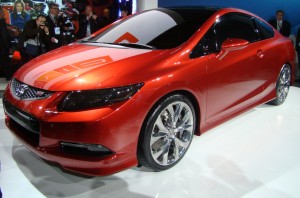
Honda braces for plant closings in North America, which could play havoc with the upcoming launch of the 2012 Civic.
It’s not going to be a good spring for Japanese automakers, the ongoing industry shutdown likely “push all companies into the red” for at least the first half of the year, warns a key industry analysts. But the impact, which has already struck General Motors, is rapidly spreading through the rest of the automotive world.
In North America and Europe – as well as Japan – supplies of key Japanese-made parts and components are rapidly dwindling. That has led several Japanese makers, Toyota and Subaru, to pare back U.S. production, as well as to a week-long shutdown at a General Motors truck plant in Louisiana. Two GM plants in Europe are now being impacted, as well, while Volvo is warning its production plans are also in jeopardy.
“This is the biggest impact ever in the history of the automobile industry,” said Koji Endo, managing director at Advanced Research Japan in Tokyo.
The worst effects, however, are being felt by Japanese makers. With only a few exceptions, auto assembly operations in the home market remain shut down. In large part, that’s a direct result of damage from the March 11 earthquake and tsunami which hammered many parts and component plants in the northeast corner of Japan.
As much as 20% of Japanese automotive semi-conductor production may have been lost for months due to the damage to one particular plant, but other silicon-based operations have also suffered at least short-term damage.
Even the production of paint pigments has been impacted, Ford Motor Co. last week forced to temporarily stop taking orders for a number of models in Tuxedo Black and three shades of red. Chrysler is also taking steps to restrict orders for some colors using Japanese pigments.
“We see the situation as severe but definiable,” said Deutsche Bank analyst Kurt Sanger. “We assume the impact to production should push all (Japanese car) companies into the red” for the first half of the fiscal year which, for makers like Toyota, Honda and Nissan, begins on April 1.
Collectively, Sanger estimated that Japanese production, initially forecast at 23 million vehicles, will come in about 15% lower.
Barring significant additional setbacks, however, the DB analysis projects the makers will be able to return to profitability during the second half of the fiscal year, beginning on October 1, “and we do not see permanent impairment to corporate value.”
But other analysts have warned that shortages of products and delays in the resumption of production could make Japanese brands more vulnerable to their European and North American competitors.
That’s especially worrisome to Honda, which on Friday issued an advisory to its North American employees that production could soon be interrupted due to parts shortages. The timing couldn’t be worse considering the upcoming launch of the 2012 Honda Civic. Long a mainstay in the compact segment, the Civic is now facing tough new competition from rivals like the new Ford Focus, Chevrolet Cruze and Hyundai Elantra.
Honda was the only Japanese automaker to report an earthquake-related death at one of its facilities. And the Tochigi technical center where that occurred is expected to be out of operation for months, which could delay future product development programs.
Toyota has announced the delay of the Japanese launch of its Prius V, a new model that will share the well-known Prius badge with a current, smaller hybrid. It is unclear whether Toyota will have to postpone the U.S. roll-out of the Prius V, scheduled for late summer.
Goldman Sachs estimates the shutdown of production has been costing Japanese automakers a collective $200 million a day. Toyota is suffering a disproportionate share of the impact not only because of its overall size but because it depends more heavily on a Japanese production base than major rivals.
Nissan may, in fact, be able to leverage its North American operations to help restart production back home. The company is considering the possibility of increasing production of engines at a plant in Decherd, TN, which would be shipped back to Japan to replace output lost when the quake and tsunami damaged a home market engine plant.
